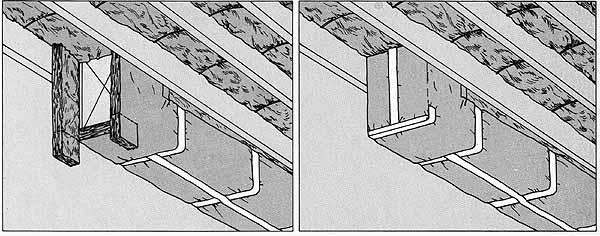Because warm air rises, some homeowners assume that a well-insulated attic is all they need. But an uninsulated basement or crawl space is an expensive nuisance. If it's heated, it needs insulation as much as any outside room. If it's both unheated and uninsulated, it may make the floors above it cold, wasting fuel and causing chills.
The worst offenders are spaces with dirt floors. Cover such floors with plastic sheeting—preferably 6-mil opaque poly ethylene. Then, if the space is unheated, install vents in the walls to pre vent condensation on basement beams and ground-floor walls. Finally, apply the insulation itself.
In a heated basement or crawl space, lay the insulation against the walls. In an unheated space, it goes against the ceiling, in batts or blankets pushed, vapor-barrier side up, between the floor joists overhead and held in place with wire braces.
This ceiling insulation does not meet all the problems of an unheated space. All heating and air-conditioning ducts should also be insulated. You may be able to buy duct blankets 2 inches thick for this purpose. If you can't get them, cut your own from the same insulation you used between the floor joists, cut ting sections to fit around the ducts, not along them. For minimum waste in cut ting, use blankets rather than batts. Make sure the vapor barrier faces you, that all exposed duct surfaces are covered and that seams are sealed with duct tape. If ducts hang so low that they might be bumped into, wrap them with 15-pound building paper to protect the vapor barrier against punctures.
In cold climates, water pipes in an unheated basement or crawl space may also need insulation to prevent supply lines from freezing and to conserve heat in hot-water lines. Use rigid cylindrical felt sleeves, sold in 3-foot lengths and in a wide range of diameters. The sleeves come with an outer canvas jacket that overlaps to help form a heat seal, but to protect them against moisture you should add a second jacket made from ordinary aluminum foil.
Insulating the Unheated Spaces

Working with batts and braces.
Push a batt of insulation, vapor-barrier side up, into the spaces between
the floor joists overhead. The barrier should just touch the subflooring.
Every 16 inches or so install wire braces—cut from wire clothes hangers
a bit longer than joist spacing—so that they barely touch the blankets;
crushing insulation reduces its effectiveness.
Wraps for Ducts

1. Working with blankets and tape.
To cover a duct, use sections of insulation cut from long blankets and wrapped crosswise around the duct. To find the length of each section,
multiply the thickness of the insulation by four and add the circumference
of the duct. To find the number of sections you need, divide the length
of the duct by the width of the blanket. Wrap the sections around the duct,
vapor barrier out, and seal the seams between the sections with duct tape. 2.
Cutting the section for the duct end. Before finishing the horizontal
duct, lay a patch of insulation against the furnace side of the vertical
duct that rises into the floor overhead. Cut a final section of insulation
to fit around the bottom and sides of the horizontal duct end and ex tend
beyond the end to a distance half the width of the duct. Tape this section
in place and cut the insulation beyond the end of the duct along the dotted
lines shown in the drawing below.

3. Trimming the tabs. Cut
off the excess insulation at the end of the duct—two tabs hanging down
from the bottom of the wrapped portion—as indicated by the dotted lines. 4.
Sealing the end of the duct. Fold the flaps of insulation beyond
the end of the duct to cover the front of the vertical duct. If the final
section does not fit the duct, so that the flaps don't meet, cut a piece
of insulation to fill the gap. If the flaps are too wide, trim them to
meet. Seal the last seams with duct tape and , if the insulated ducts hang
below the top of your head, cover them with 15-pound building paper.

Insulating a recessed duct.
To insulate a duct nestled between two joists, cut blanket sections long
enough to reach the outside edges of the adjoining joists. Push the insulation
an inch or so back from the ends of each section, leaving the vapor barrier
intact. Wrap the insulation around the bottom of the duct with the vapor
barrier out, and staple the exposed barrier to the bottoms of the joists.
For the part that enters the floor overhead, cut a section that extends
beyond the edge of the duct for a distance equal to the thickness of the
insulation; cover the end of the duct with a patch of insulation and seal
all seams with duct tape.
A Vapor Barrier for a Dirt Floor
(above, bottom) Laying plastic strips. Cover an unpaved basement or crawl-space floor with strips of 6-mil polyethylene plastic, with overlaps of about 6 inches. Strips about 3 feet wide are easiest to work with. Use duct tape to fasten the end of each strip to the wall 2 inches above the ground, and tape the plastic down where the wall meets the ground. Trim off excess plastic and weight the overlaps with bricks or stones.
Sleeves for Piping

1. A close-fitting sleeve.
Clean the pipes, scraping off any rust and sealing all leaks, however small.
Cover the pipes with lengths of cylindrical pipe insulation and glue the
lap down tightly. To make short sections of insulation, cut the insulation
with a utility knife or a handsaw. 2. Taping the fittings.
Cover the pipe fittings with insulation tape 1/4 inch thick. Be sure to
cover the fittings completely: no part should be exposed to air. To complete
the job, wrap both the pipe and the fittings in aluminum foil.
Other articles from Weatherproofing (T-L) on our compactdynamics.com site: